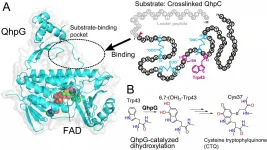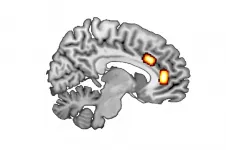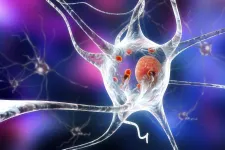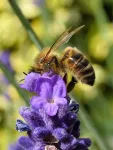The chemistry lab inside cells
A research team led by Osaka University has identified the protein used by the body to convert amino acids into the enzyme cofactor cysteine tryptophylquinone, which may lead to the development of novel biological catalysts
2021-02-10
(Press-News.org) Osaka, Japan - Investigators from the Institute of Scientific and Industrial Research at Osaka University, together with Hiroshima Institute of Technology, have announced the discovery of a new protein that allows an organism to conduct an initial and essential step in converting amino acid residues on a crosslinked polypeptide into an enzyme cofactor. This research may lead to a better understanding of the biochemistry underlying catalysis in cells.
Every living cell is constantly pulsing with an array of biochemical reactions. The rates of these reactions are controlled by special proteins called enzymes, which catalyze specific processes that would otherwise take much longer. A number of enzymes require specialized molecules called "cofactors," which can help shuttle electrons back and forth during oxidation-reduction reactions. But these cofactors themselves must be produced by the organisms, and often require the assistance of previously existing proteins.
Now, a team of scientists at Osaka University has identified a novel protein called QhpG that is essential for the biogenesis of the enzyme cofactor cysteine tryptophylquinone (CTQ). By analyzing the mass of the reaction products and determining its crystal structure, they were able to deduce the catalytic function of QhpG, which is adding two hydroxyl groups to a specific tryptophan residue within an active-site subunit QhpC of quinoheme protein amine dehydrogenase, the bacterial enzyme catalyzing the oxidation of various primary amines. The resulting dihydroxylated tryptophan and an adjacent cysteine residue are finally converted to cofactor CTQ.
However, the action of QhpG is somewhat unusual compared with other protein-modifying enzymes in that it reacts with the tryptophan residue on the QhC triply crosslinked by another enzyme QhpD in a process call post-translation modification. Tryptophan, which naturally contains rings with conjugated bonds, needs the fewest changes to become a quinone cofactor. "Although several enzymes are known to contain a quinone cofactor derived from a tryptophan residue, the mechanism involved in post-translational modification, as well as the structures of the enzymes involved in their biogenesis, remains poorly understood," lead author Toshinori Oozeki says.
The proteins were obtained by introducing plasmids with the corresponding genes into E. coli bacteria and made into crystals. X-ray diffraction data of the crystal can determine the QhpG protein structure. The team then used computer software to simulate the docking of the target molecules, the triply crosslinked polypeptide QhpC, based on the crystal structure they found for QhpG. The two post-translational modifications of QhpC are successively carried out in the modification enzyme complex QhpD-QhpG. "Our findings can be applied to development of novel bioactive peptides using enzymes that modify amino acids," senior author Toshihide Okajima says. Some of these applications include creating new enzymes for the bioremediation of toxic chemicals.
INFORMATION:
The article, "Functional and structural characterization of a flavoprotein monooxygenase essential for biogenesis of tryptophylquinone cofactor," was published in Nature Communications at DOI: https://doi.org/10.1038/s41467-021-21200-9
About Osaka University
Osaka University was founded in 1931 as one of the seven imperial universities of Japan and is now one of Japan's leading comprehensive universities with a broad disciplinary spectrum. This strength is coupled with a singular drive for innovation that extends throughout the scientific process, from fundamental research to the creation of applied technology with positive economic impacts. Its commitment to innovation has been recognized in Japan and around the world, being named Japan's most innovative university in 2015 (Reuters 2015 Top 100) and one of the most innovative institutions in the world in 2017 (Innovative Universities and the Nature Index Innovation 2017). Now, Osaka University is leveraging its role as a Designated National University Corporation selected by the Ministry of Education, Culture, Sports, Science and Technology to contribute to innovation for human welfare, sustainable development of society, and social transformation.
Website: https://resou.osaka-u.ac.jp/en
About Hiroshima Institute of Technology
At the Hiroshima Institute of Technology, we are guided by the educational approach expressed in our university's philosophy, "Education is love," and motto, "Always Walk Together with God and Serve Humanity" as we endeavor to cultivate engineers and technical experts who will make the world a better place.
The new "HIT.E▸2024" educational program aimed at cultivating pioneering engineers and technical experts began in April 2020. This program fosters an environment where student-driven, active and ongoing learning takes place, with students' existing expertise and confidence being complemented by stronger connections to society that will cultivate real-world practical competencies truly applicable in the society of tomorrow.
As part of the HIT.E▸2024 program, first year students in all departments will be required to take the "Introduction to AI and Data Science" introductory level AI and data science course. In addition, we have established the Department of Information and Communication in order to equip students capable of utilizing information to create social value. Through a curriculum carefully adapted to the changing times, this department produces the sorts of engineers and technical experts that are demanded by society and local communities.
[Attachments] See images for this press release:

ELSE PRESS RELEASES FROM THIS DATE:
2021-02-10
As indicated by other studies, different parts of the brain are responsible for different types of decisions. A research team led by Luca Franziska Kaiser and Prof. Dr. Gerhard Jocham from the HHU working group 'Biological Psychology of Decision Making', and Dr. Theo Gruendler together with colleagues in Magdeburg analysed the balance of the messenger substances GABA and glutamate in two forms of decision-making. The background to the research was to find out how different concentrations of these substances influence the person making the decision.
On the one hand, the researchers looked at 'reward-based decisions', which involve maximising reward by selecting the better of two ...
2021-02-10
It is now possible to capture images of planets that could potentially sustain life around nearby stars, thanks to advances reported by an international team of astronomers in the journal Nature Communications.
Using a newly developed system for mid-infrared exoplanet imaging, in combination with a very long observation time, the study's authors say they can now use ground-based telescopes to directly capture images of planets about three times the size of Earth within the habitable zones of nearby stars.
Efforts to directly image exoplanets - planets outside our solar system - have been hamstrung by technological limitations, resulting in a bias toward the detection of easier-to-see planets that are much larger than Jupiter and are located around very young stars and far outside the ...
2021-02-10
A study published in Nature Communications today (Wednesday 10 February) presents a compelling new evidence about what a key protein called alpha-synuclein actually does in neurons in the brain.
Dr Giuliana Fusco, Research Fellow at St John's College, University of Cambridge, and lead author of the paper, said: "This study could unlock more information about this debilitating neurodegenerative disorder that can leave people unable to walk and talk. If we want to cure Parkinson's, first we need to understand the function of alpha-synuclein, a protein present in everyone's brains. ...
2021-02-10
While deforestation levels have decreased significantly since the turn of the 21st century, the United Nations (UN) estimates that 10 million hectares of trees have been felled in each of the last five years.
Aside from their vital role in absorbing CO2 from the air, forests play an integral part in maintaining the delicate ecosystems that cover our planet.
Efforts are now underway across the world to rectify the mistakes of the past, with the UN Strategic Plan for Forests setting out the objective for an increase in global forest coverage by 3% by 2030.
With time being of the essence, one of the most popular methods of reforestation in humid, tropical regions ...
2021-02-10
Commuters now have yet another reason to avoid packing themselves into subway stations. New York City's transit system exposes riders to more inhaled pollutants than any other metropolitan subway system in the Northeastern United States, a new study finds. Yet even its "cleaner" neighbors struggle with enough toxins to give health-conscious travelers pause.
Led by NYU Grossman School of Medicine researchers, the study measured air quality samples in 71 stations at morning and evening rush hours in Boston, New York City, Philadelphia, and Washington, D.C. ...
2021-02-10
A treatment, known as KEDRAB (Rabies Immune Globulin [Human]), currently used in the prevention of rabies has been demonstrated to be safe and effective for patients age 17 and under.
Results published today in Human Vaccines & Immunotherapeutics report the first and only pediatric trial of any human rabies immunoglobulin (HRIG) currently available in the US. Findings have been submitted to the US Food and Drug Administration for review.
In the United States, someone is treated for possible exposure to rabies every 10 minutes. Globally, the World ...
2021-02-10
A new paper in Oxford Open Immunology, published by Oxford University Press, examines prior findings in the field of neuroimmunology that suggest potential treatment strategies for patients suffering long-term symptoms from COVID-19.
Though COVID-19 was initially believed to be a short-term illness, lasting between one and three weeks, it's clear that a substantial number of patients will experience symptoms beyond that, with some patients suffering from health problems for more 12 weeks. In fact, for patients who were initially hospitalized, more than 80% reported at least one symptom that persisted beyond the first month.
The symptoms of long-COVID can vary widely, ...
2021-02-10
Yams are a staple food in West Africa, which produces over 90% of the world's yams each year. Yams play a key role in the food security, economic income, and traditional culture for the region.
While they are commonly assumed to be the same as sweet potatoes in the U.S., yams are a completely different plant. The yam tubers are much starchier and drier compared to sweet potatoes. Yams are native to Africa and Asia, and most Americans have never had a true yam.
Even though yam is a staple crop for West Africa, there has been limited research to improve the genetic diversity or productivity.
Researcher Shinsuke Yamanaka focuses on improving crop breeding resources for ...
2021-02-10
Tungsten hexanitride with armchairlike hexazine N6 ring has been synthesized by a group of scientists led by Dr. Jin Liu and his former postdoc Nilesh Salke at HPSTAR (Center for High Pressure Science & Technology Advanced Research). WN6 is a promising high-energy-density and superhard material. Their findings are published in the recent issue of Physical Review Letters.
Diatomic nitrogen is the most abundant molecule in Earth's atmosphere accounting for almost 78% volume. The strong triple bond in nitrogen makes it very stable and unreactive at near ambient conditions. However, in the intense-pressure and high-temperature conditions, nitrogen will behave entirely differently, it can form double- or even single-bonded structure or react with other elements ...
2021-02-10
As abundant and widespread bees, it is common to see both bumble bees and honey bees foraging on the same flower species during the summer, whether in Britain or many other countries.
Yet researchers at the Laboratory of Apiculture and Social Insects (LASI) at the University of Sussex, have found that different bees dominate particular flower species and revealed why.
By studying 22 flower species in southern England and analysing the behaviour of more than 1000 bees, they found that 'energy efficiency' is a key factor when it comes to mediating competition.
Bee bodyweight and the rate at which a bee visits flowers determine how energy efficient they are. Bodyweight determines the energy used while flying and walking between flowers, with a bee ...
LAST 30 PRESS RELEASES:
[Press-News.org] The chemistry lab inside cells
A research team led by Osaka University has identified the protein used by the body to convert amino acids into the enzyme cofactor cysteine tryptophylquinone, which may lead to the development of novel biological catalysts






